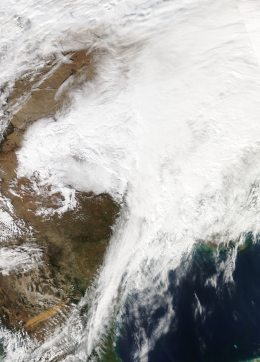 Satellite image from NASA depicting the system over the Central United States on 21 December. | |
| Type | Ice storm Winter storm Tornado outbreak Extratropical cyclone |
|---|---|
| Formed | 19 December 2013 |
| Dissipated | 23 December 2013 |
| Lowest pressure | 997 mb (29.44 inHg) |
| Tornadoes confirmed | 13 |
| Max. rating1 | EF2 tornado |
| Duration of tornado outbreak2 | 2 days, 6 hours and 4 minutes |
| Maximum snowfall or ice accretion | Snowfall – ~36 cm (14 in) Ice – Around 30 mm (1.2 in)[1] |
| Fatalities | 29[2] |
| Damage | $54 million – $200 million (2013 USD) |
| Power outages | 1,500,000 |
| Areas affected | Southern Ontario, Southern Quebec, Upper Midwest, Great Plains, Southeastern United States, East Coast, Michigan, northern New England, Nova Scotia, Canada, Newfoundland,[3] |
Part of the 2013–14 North American winter and tornado outbreaks of 2013 1Most severe tornado damage; see Fujita scale 2Time from first tornado to last tornado | |
The December 2013 North American storm complex was a significant storm complex that included many different types of severe weather, including a winter storm, a severe ice storm and a tornado outbreak that impacted the central and eastern portions of Canada, parts of the Central Great Plains, the Southern United States, and the northeastern United States from 20 to 23 December 2013.[4][5] Formed in the South Central United States, the storm headed across the Great Plains towards Canada into Atlantic Canada and northeastern United States where the storm dissipated on 23 December 2013.[6] The storm produced freezing rain and snow to the affected areas which caused massive damage to electric power transmission and trees.[7] The storm resulted in 29 deaths, loss of power to over a million residents and over $200 million in damages.[8] The storm produced similar conditions to the ice storm of 1998 which affected similar areas.
- ^ "US and Canada storms spell cold, dark Christmas for many". BBC News. 24 December 2013. Retrieved 15 August 2014.
- ^ Cite error: The named reference
reportnumberwas invoked but never defined (see the help page). - ^ "Tens of thousands in U.S., Canada without power days after ice storm". CNN. 25 December 2013. Retrieved 28 December 2013.
- ^ "Ice storm means dark Christmas for tens of thousands". CBC News. 25 December 2013. Retrieved 25 December 2013.
- ^ Edmiston, Jake (22 December 2013). "'Catastrophic ice storm' slams into Toronto, strands travellers across the province". National Post. Retrieved 25 December 2013.
- ^ "December 21–22 Ice Storm Summary". National Weather Service Weather Forecast Office. NOAA. Retrieved 9 October 2014.
- ^ "The Year in Weather: 2013 Oklahoma and Western North Texas". National Weather Service Weather Forecast Office. NOAA. Retrieved 9 October 2014.
- ^ Acharya-Tom Yew, Madhavi (20 January 2014). "Ice storm pushed weather losses to record $3.2 billion: Insurance Bureau". The Toronto Star. Torstar. Retrieved 9 October 2014.